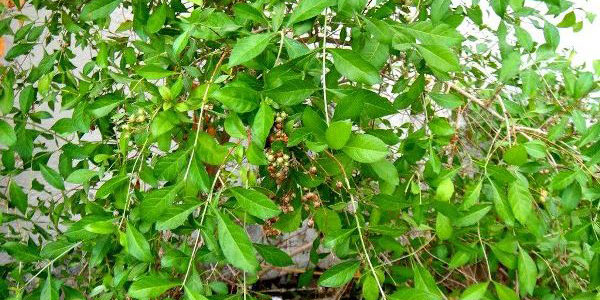About Henna
It is a small shrub of about 3 to 5 feet in height whose leaves are used for natural colouring and conditioning of hair. The leaves are green in colour but is imparts a brownish red colour. Henna is well known for it's natural value, pleasant fragrance, colouring and cooling effects. It is also used for making temporary tattoos since centuries. Although henna is found in many countries but henna from India is considered the best.

Lawsone Pigment
Henna (Lawsonia inermis, also known as hina, the henna tree, the mignonette tree, and the Egyptian privet) is a flowering plant and the sole species of the Lawsonia genus. The English name "henna" comes from the Arabic حِنَّاء (ALA-LC: ḥinnāʾ; pronounced [ħɪnˈnæːʔ]) or, colloquially حنا, loosely pronounced as /ħinna/. Mehndi (Henna) applied on both hands.
The name henna also refers to the dye prepared from the plant and the temporary body art (staining) based on those dyes (see also mehndi). Henna has been used since antiquity to dye skin, hair and fingernails, as well as fabrics including silk, wool and leather. Historically, henna was used in the Arabian Peninsula, South Asia, parts of South East Asia, Carthage, other parts of North Africa and the Horn of Africa. The name is used in other skin and hair dyes, such as black henna and neutral henna, neither of which is derived from the henna plant.
CULTIVATION
Henna plant is grown in semi-arid zones and tropical regions. It is grown in North Africa, West and South Asia, North Australia, India Subcontinent and Arabian Peninsula. The henna plant can be grown in such regions where the temperature is between 35-45 degreesCelsius. The henna plant grows steadily. The henna plant cannot survive in too much hot or cold climatic condition. Best quality Henna is grown in the state of Rajasthan in India.
BODY ART
Henna body art is very popular among women and young girls. For creating tattoos and designs, Henna paste is applied to various parts of the body especially hands, feet, and fingernails. Henna leaves contain lawsone pigment which imparts color. You can add lemon juice, tea leaves, and essential oils with the henna powder to get the darker color.After applying on hands and feet, you can dab a solution of lemon juice mixed with sugar. This solution averts henna from drying and falling from the skin. A tint of orange color is found on hands and feet as soon as the henna paste is brushed or scraped away. After 1-2 days the color gets darker and the designs or tattoo looks beautiful and amazing.
Henna Hair Color
The art of coloring hair with henna is a very old tradition. Several applications of henna paste make your hair texture shiny, soft and silky.At present, men also use henna to color their hair and beard as well.Henna is mixed with several hair care herbs which nourished the hair and give beautiful color. After a detailed R and D a new product called Henna based hair colors has been developed to give different colors ranging from Black, Dark Brown, Brown, Burgundy etc. This henna covers the grey hair completely and gives excellent results.
.jpg)



